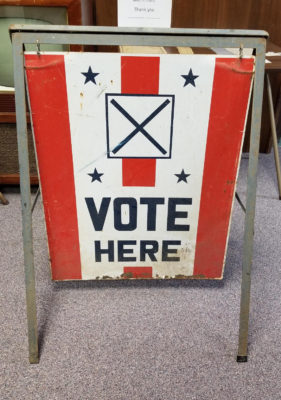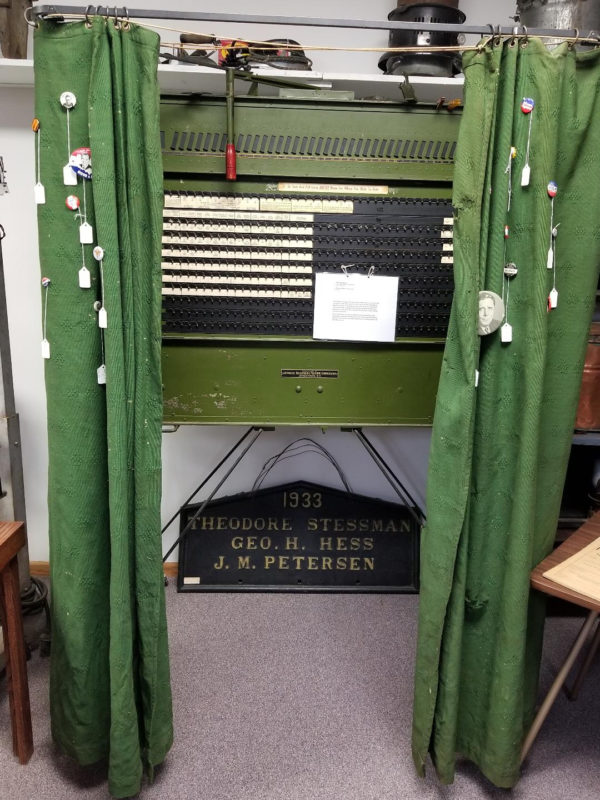“Voting in Shelby County”: a curator’s perspective
04 March 2019 – Sarah A. McDonald

Voting in Shelby County exhibit entrance sign Photo credit: Shelby County Historical Society and Museum
The Shelby County Historical Society and Museum (SCHSM) is a small organization situated in rural western Iowa. For over fifty years, the SCHSM has stood as a point of pride for community members. Founded by local citizens eager to collect and preserve the history of Shelby County, the museum’s collection consists mainly of items, ranging from household objects to antique cars, related to life in rural Iowa. Over the last few years, the museum and its board of directors have undertaken the challenge of transitioning from a volunteer-run organization to a professional museum. With that comes the challenge of creating modern exhibitions that are relevant to current societal issues and events within the context of a small, long-established community that is not always open to change.
In pursuit of that goal, Voting in Shelby County, which ran from October 10, 2018 through November 20, 2018, was designed to be an exhibition about voting—both its history and present-day applications. The exhibition provided a brief history of voting rights, outlined types of elections and voting methods, and ended with interactives such as “Leave Your Voice.” The interactive gave visitors the chance to name what they deemed important qualities in their elected leaders—respectfulness and honesty were the most popular. In order to provide an overview of the history of voting rights, the exhibition focused on the Nineteenth Amendment and the Civil Rights Act of 1965. We interpreted the history of debate surrounding the latter using a 1950s-era television from the collection. Visitors also viewed a functional Automatic Voting Machine from circa 1911.
Although Shelby County is not racially diverse, and the museum’s collections reflect the area’s largely white majority, the history of the county’s African American citizens is relevant to all residents and to the county’s place in American history. According to CensusViewer, Caucasians made up 97.88% of the county’s population in 2010. The museum’s mission is to collect and preserve the history of Shelby County, Iowa. Because the museum’s collection is made up of donations from community members in a historically white county, very few of the collection items related to African American history. Therefore, the exhibition was curated to make the best use of the museum’s collection while providing context for the county’s unique history.
The exhibition’s inclusion of the Nineteenth Amendment related more directly to Shelby County residents, over half of whom are women, as well as our collections. In this section of the exhibition, we were able to link collection objects to women’s suffrage. The exhibition featured the charter of a club created by Shelby County women in the 1890s to promote the cause of female suffrage. The exhibition also included a newspaper article discussing whether or not women had the right to vote in a community matter in the early 1900s. These items illustrated that the relationship between women’s citizenship and their right to vote affected the entire country, putting local history into a national context.
The exhibition opened with a viewing party for the final Iowa gubernatorial debate on October 21, 2018. The exhibition opened prior to Election Day in the hopes that visitors would become more aware of their voting rights and the associated logistics leading up to Election Day in Iowa. We approached the Shelby County Auditor’s Office about the possibility of their providing “I Voted” stickers for visitors. Not only did they agree, but they were eager to help us out by providing voter registration and absentee ballot registration forms in an effort to increase voter turnout in the county. Working with the auditor’s office was a great way to establish a mutually-beneficial community partnership.
My goals for the exhibit were twofold. First, I wanted to provide a historical framework for the development of voting rights and illustrate the ways that groups have worked to expand voting rights throughout American history. Secondly, I wanted to use that framework to provide visitors with context for current debates surrounding voter ID laws, as seen in articles published by The Crescent-News, The Daily Illini, and many other publications. That said, the connection between the exhibition and current voter ID debates was not overtly addressed in the exhibition. If I had the chance to recreate the exhibition, I would explicitly address contemporary voting rights issues. Being new in the community, I was unsure of how such a message would be received. As a public historian, I missed the opportunity to demonstrate the relevance of history. Discussing this point within the exhibition would have enhanced visitors’ perspective on their neighbors’struggles to utilize their right to vote and learn that we all have more in common than we see at first glance.
Throughout the process of creating and curating the Voting in Shelby County exhibition, I learned that such a broad topic would be better covered in two exhibitions, one about the history of voting rights and another about the nuts and bolts of elections and voting. Doing so would allow more in-depth coverage of each topic, and would provide the opportunity for more community involvement. A larger exhibition about the history of voting rights would be an interesting opportunity to cooperate with local educators to align the exhibit’s content and timing with the curriculum being taught in their classrooms. A smaller, pop-up exhibit about the specifics of elections and voting would be especially beneficial during local, state, and federal elections, and would present the opportunity for further cooperation with the Shelby County auditor’s office and other local organizations.

Automatic Voting Machine, donated by the Shelby County Courthouse Photo credit: Shelby County Historical Society and Museum
Finally, I made deeper connections between ideas and facts that I had already been aware of. I knew that American colonists wanted a say in the colonial government. I knew that women did not gain the right to vote until almost 150 years after the founding of the United States of America. I knew that had I turned eighteen before 1971, I would have had to wait three more years before I could vote. But never before had I drawn a line from the colonists’ struggle to vote, to suffragettes marching across the country, to marginalized communities currently struggling to exercise their right to vote. It occurred to me that every group in America had fought for the right to vote. And that fight is not over.
~Sarah A. McDonald earned her B.A. in anthropology from Texas Tech University and her M.A. in history and museum studies from the University of New Hampshire. She is the executive director of the Shelby County Historical Society and Museum in Harlan, Iowa.




I viewed this exhibit at the museum. I enjoyed reading about the thought process that went into its development and the ideas for making it even better in the future. Excellent work, Sarah McDonald and Shelby County Historical Siciety and Museum!
Sarah,
Exceptional piece on your little corner of the World. I imagine Shelby County something like the place where I vote. The Registrar has been the same for nearly 20 years, and despite being stationed around the World, she still remembers me every year. I imagine that voting is much more personable there, and it sounds like someplace I would like to cast my votes.
Isn’t it amazing that we’ve come so far in such a short time? People are so resistant to change, and we need examples such as this to even the score, not just in voting, but in all aspects of life.
Keep looking backwards to help us look forward. You’re absolutely right, that fight is not over!